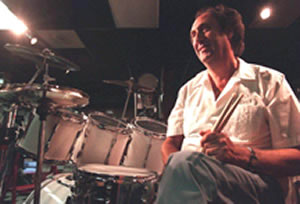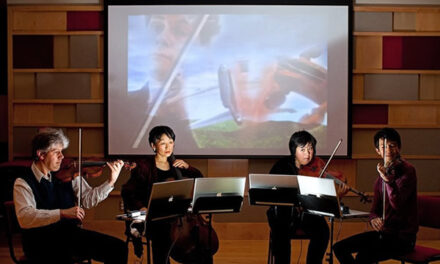Perhaps because our return visit was in the afternoon rather than the evening, we could easily forget that we had attended a concert at Davidson College Presbyterian Church once before. The place makes a different visual impression when you enter by day, but the acoustic remains splendid in any light. So does the North Carolina Baroque Orchestra, which I’m now reviewing for the third time in the last three years – while the ensemble has kept roaming as far east as Winterville, with stops along the way for concerts in Raleigh, Durham, Cary, Kinston, Winston-Salem, Greenville, and Rocky Mount in between. The ensemble’s latest program, “Music for the Sun King,” had been presented in Raleigh two nights earlier, with music by Handel, Rameau, Vivaldi, Lully, and Telemann.
As I discovered in the first NCBO concert I reviewed in Charlotte, “Christmas in Venice,” conductor Frances Blaker doesn’t coyly hold onto the best-loved piece in a program until the end of a concert. Nor apparently does she so strictly construe the title of a concert that it limits her programming choices. That became obvious when the “Sun King” concert began with a sampling of Handel’s Water Music, written for King George I and famously premiered on the River Thames in 1717, two summers after Louis XIV’s death at Versailles. The chancel at Davidson Presbyterian gave warmth and distance to the horns and cellos at the rear of the orchestra while the treble of the violins and violas, standing at the vanguard of the ensemble, came through with vivid clarity.
The two valveless horns, wielded by Chris Caudill and Rachel Niketopoulos, struggled noticeably getting off the mark in the opening Allegro, the first of three markings in the opening movement, but they proved nearly as trusty as any of the benchmark recordings, which can also be bumpy rides for the hornists. No such problems for the seven-piece wind section, wafting into the Andante midsection of the movement, and the horns reasserted their authority once they reached cruising gear in the final closing Allegro section. Flutes and recorder combined deliciously with the cheery violins in the ensuing Menuet, where the horns again reached peak form in the ending. Oboists Alicia Chapman and Sarah Weiner then demonstrated how clear and trumpet-like the double-reed instruments can sound in the Air movement, before the orchestra concluded their Water Music sampler with its most familiar melody. Although labeled Allegro on the program, I haven’t been able to find a recording that calls it anything but a hornpipe. More to the point, Blaker definitely knew what to do with the tempo, avoiding the ugly sprint you’ll find on the Orpheus Chamber Orchestra recording, bringing the piece to a close with a welcome mellowness mixed into its brisk pace.
Blaker programmed a larger sampling of Rameau two years ago in Davidson at the “Musical Banquet” concert, when the NCBO fielded 27 musicians, eight more than this time around. But the bigger disappointment was that the ensemble didn’t bring anything different to the table. Once again, the flutes soared heavenward to frame the violins – and briefly, Richard Krumdieck’s bassoon – in the excerpt from Les Boréades. Flutist Catherine Bull put down her instrument long enough to ping a triangle and launch the Chaconne that closes Rameau’s Dardanus, melting afterwards into the sweet wind choir. The oboes peeled away, once again sounding like trumpets, and the upper strings played some impressively swift passages together before the whole ensemble produced a deeply satisfying blend as the piece reached its stately ending.
Vivaldi’s operas came at the tail end of the Red Priest’s rediscovery, and the first DVD of Il Farnace was released earlier this year, so it wasn’t surprising or unforgivable for Blaker to candidly admit she had no idea what the opera was about as she introduced its Sinfonia. From what I’ve been able to gather, thanks in part to a YouTube video with French subtitles, the Sinfonia could easily be labeled an overture, since its three parts occur before the action begins. The first, marked Allegro in brackets, instantly asserted the composer’s distinctive vivacity with his characteristic changes in dynamics. Less recognizable but equally distinctive, the collective sound of the orchestra was startlingly different, as if we had a new ensemble in front of us. Interplay between the first and second violins marked the middle Andante section, yet enough restlessness remained in the tempo to keep us anticipating the speed-up to come. When it did, we seemed to circle back to the brisk poise of the Handel hornpipe – not quite torrid enough for an Allegro by Vivaldi and missing that punch we expect when he abruptly lurches into fortissimo.
While a double-check on Rameau will confirm that he was French, his musical genius developed too late to attract the notice of the Sun King. When he did achieve celebrity, he matched the prestige of his predecessors, Jean-Baptiste Lully and François Couperin, composers of previous generations who did find favor in Louis XIV’s court. To Lully, however, goes the credit of justifying the “Sun King” concept for this concert, with a couple of lovely instrumental settings from Le Bourgeois Gentilhomme, a 1670 comédie-ballet collaboration written while he was still on good terms with Molière. Blaker’s best-spoken intro was lavished upon these pieces as she told us how the Italian-born Lully not only rose to pre-eminence in Louis XIV’s court, but also became the prime arbiter of what was truly French in music. It would have been quite deflating if the music that followed proved to be dull and academic, but the two pieces chosen, “Marche pour le Cérémonie des Turcs” and the “Chaconne des Scaramouches, Trivelins et Arlequins,” both justified Blaker’s enthusiasm. Once again, the texture of the orchestra was refreshed in the march as cellists Sally Blaker and Barbara Blaker Krumdieck became more prominent in the music and Caudill put down his horn to beat the rhythm on a hand drum. Krumdieck played the lone cello behind the winds at the start of the chaconne until the violins carried the melody, punctuated by the oboes in their trumpet disguises, until a swaying 3/4-time ensemble concluded the harlequinade with smiling dignity.
Another charming introduction awaited us before the final morceau, three choice movements from Telemann’s Ouverture-Suite in F, TWV 55:F3. Inadvertently no doubt, Blaker gave me the impression that she had unearthed this piece and that we were among the first to hear it. As she showed us the scores she had distributed among the musicians, photocopies of what looked like papyrus dating back to the Dead Sea Scrolls, one of the second violinists made a mock stabbing motion at the conductor as she lauded the ensemble’s forbearance. Thanks to the Presto-Amazon-Spotify triumvirate, which logged at least four recordings of the piece in the past 25 years, I later learned that the suite has eight movements, of which we heard the first, second, and the last: Ouverture – Rondeau – Fanfare.
Each movement had special charms, radiating once again a distinctively different orchestral sound, wide open in the Ouverture and grander than anything that had preceded. The horns not only crowned the grandeur, they also negotiated some challenging runs. Oboes added more of their brassy sound, this time in lively dialogue with the violins. A welcome change from all the slow middle movements we’re accustomed to in baroque music, the Rondeau actually resembles the opening movement of Bach’s fifth Brandenburg Concerto, and the horns, dramatically split up to opposite sides of the stage, delivered Bach-like harmony. Predictably, the final Fanfare was even showier for the horns, upstaging the vibrant passages of violins as decisively as the oboes. Notwithstanding some recycled content, this was another scintillating NCBO event. Next time they play for the Sun King, I’d hope they would bring fresher offerings from Rameau. Fulfilling Blaker’s grim prophecy, the two harpsichords never were audible. So perhaps a couple of Couperin’s renowned solo pieces on a future program would offer each of them compensation – and a chance to shine as brightly as their colleagues.












